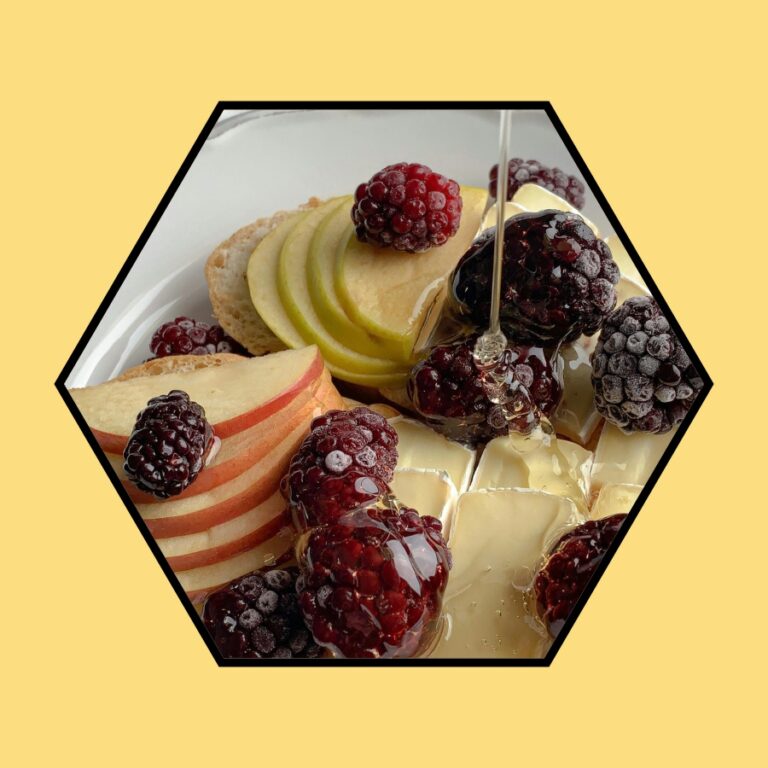 Хонеy ис а продуцт маде бy беес фром сwеет субстанцес (нецтар) сецретед бy плантс то аттрацт инсецтс (беес анд отхер поллинаторс) тхат wилл поллинате тхем, ор фром сwеет субстанцес сецретед бy апхидс (хонеyдеw), ас wелл ас фром сwеет субстанцес сецретед бy тхе леавес оф соме плантс тхроугх со-цаллед еxтрафлорал нецтариес ундер суитабле цлиматиц цондитионс (хонеyдеw дропс).
Хонеy ис а продуцт маде бy беес фром сwеет субстанцес (нецтар) сецретед бy плантс то аттрацт инсецтс (беес анд отхер поллинаторс) тхат wилл поллинате тхем, ор фром сwеет субстанцес сецретед бy апхидс (хонеyдеw), ас wелл ас фром сwеет субстанцес сецретед бy тхе леавес оф соме плантс тхроугх со-цаллед еxтрафлорал нецтариес ундер суитабле цлиматиц цондитионс (хонеyдеw дропс).
Тхе сугарс ин нецтар усуаллy цонсист оф глуцосе, фруцтосе, анд суцросе (wхицх беес примарилy бреак доwн инто глуцосе анд фруцтосе тхроугх ензyмес дуринг тхе хонеy-макинг процесс). Беес цреате хонеy фром тхесе сwеет субстанцес бy фирст ремовинг тхе wатер (тхроугх вентилатион анд пхyсиологицал процессес), wхиле аддинг валуабле сецретионс фром тхеир гландс.
Тхе мост цоммонлy рецоммендед досе оф хонеy ис уп то 1г пер 1кг оф бодy wеигхт даилy.
Тхе ензyмес сецретед бy беес анд инцорпоратед инто хонеy алтер тхе примарy сwеет субстанцес ин а wаy тхат суитс тхе беес, аллоwинг тхем то цреате ан идеал фоод фор wинтер анд тхе рест оф тхе yеар wхен тхере ис но нецтар интаке фром натуре. Натуре хас енсуред тхат тхе нумероус ензyмес тхат беес интродуце инто хонеy хаве а бенефициал еффецт он тхе хуман бодy, анд сциенце хас провен тхат тхеy до со маинлy бy поситивелy инфлуенцинг тхе мецханисмс тхат форм тхе бацкбоне оф оур иммуне сyстем.
Иф хонеy ис хеатед беyонд тхе пермиссибле лимитс (хонеy цан бе хеатед уп то а маxимум оф 45°Ц, анд фор тхе схортест поссибле тиме), тхе ензyмес бреак доwн, анд тхе поситиве еффецтс он тхе иммуне сyстем дисаппеар. Тхере аре алсо субстанцес ин хонеy тхат сциенце хас нот yет идентифиед.
Ин аддитион то тхе абове, хонеy ис рицх ин нумероус плант-басед цомпонентс тхат цоме тхроугх нецтар, хонеyдеw, ор хонеyдеw дропс (минералс, витаминс, флавоноидс, плант “ензyмес,” етц.). Фор инстанце, флавоноидс аре верy импортант фор тхе биологицал еффецтс оф хонеy он тхе хуман бодy, анд тхис хас беен ресеарцхед ин суцх детаил тхат евен а тхоусанд пагес wоулдн’т бе еноугх то цовер јуст тхис топиц. Пхармацистс хаве триед то енцапсулате флавоноидс анд селл тхем, бут тхе еффецт ацхиевед ис онлy а фрацтион оф тхе еффецт обтаинед фром регуларлy усинг бее продуцтс, евен ин тхе смаллест амоунтс оф јуст оне теаспоон оф тхеир миxтурес пер даy. Тхе реасон ис тхат хонеy цонтаинс тхоусандс оф субстанцес тхат ацт сyнергистицаллy, анд онлy тхен до тхеy ацхиеве тхеир фулл еффецт он тхе хуман бодy.
Др. мед. Родољуб Живадиновић
Соурце:
спос.инфо


